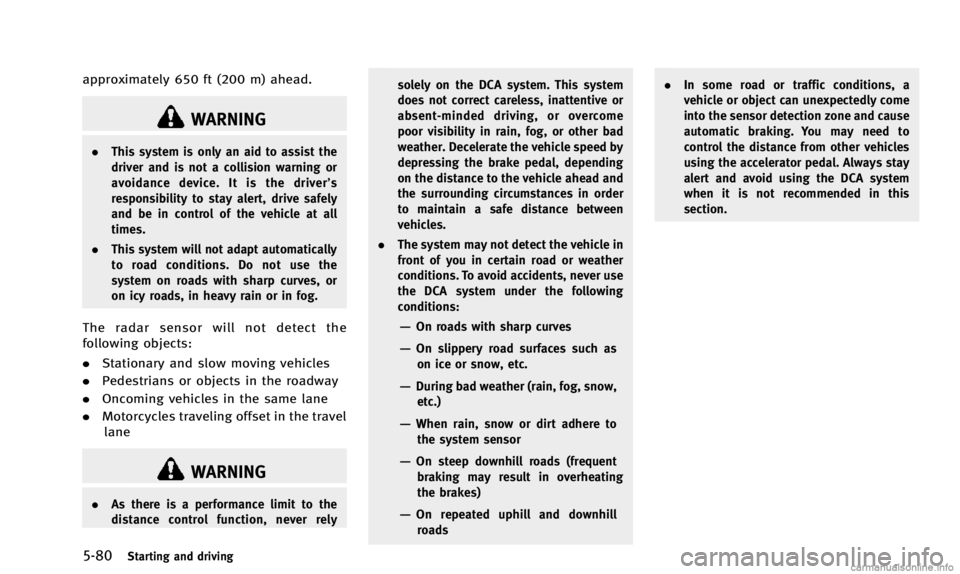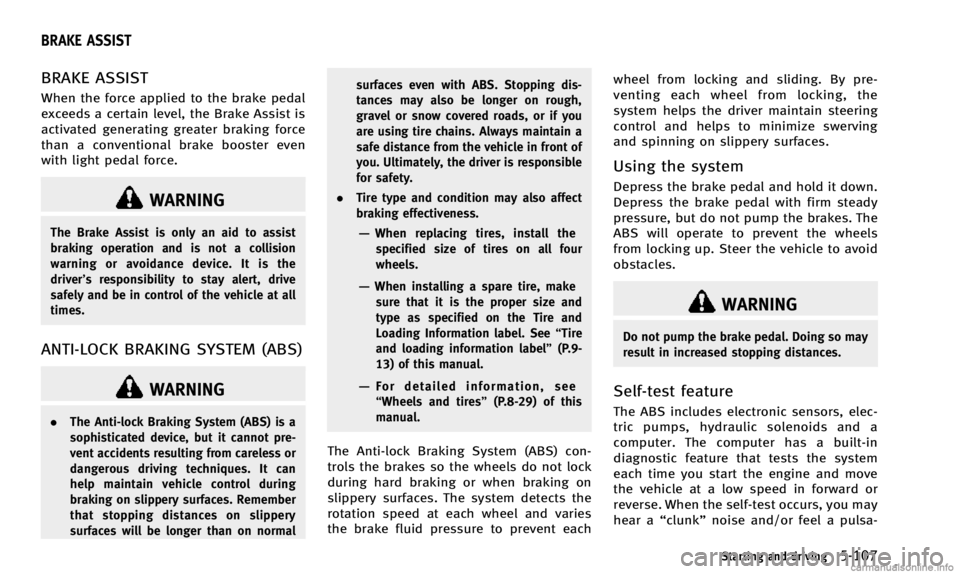ESP INFINITI Q50 2014 Owner's Guide
[x] Cancel search | Manufacturer: INFINITI, Model Year: 2014, Model line: Q50, Model: INFINITI Q50 2014Pages: 394, PDF Size: 1.99 MB
Page 255 of 394

5-80Starting and driving
approximately 650 ft (200 m) ahead.
WARNING
.This system is only an aid to assist the
driver and is not a collision warning or
avoidance device. It is the driver’ s
responsibility to stay alert, drive safely
and be in control of the vehicle at all
times.
. This system will not adapt automatically
to road conditions. Do not use the
system on roads with sharp curves, or
on icy roads, in heavy rain or in fog.
The radar sensor will not detect the
following objects:
.Stationary and slow moving vehicles
. Pedestrians or objects in the roadway
. Oncoming vehicles in the same lane
. Motorcycles traveling offset in the travel
lane
WARNING
. As there is a performance limit to the
distance control function, never rely solely on the DCA system. This system
does not correct careless, inattentive or
absent-minded driving, or overcome
poor visibility in rain, fog, or other bad
weather. Decelerate the vehicle speed by
depressing the brake pedal, depending
on the distance to the vehicle ahead and
the surrounding circumstances in order
to maintain a safe distance between
vehicles.
. The system may not detect the vehicle in
front of you in certain road or weather
conditions. To avoid accidents, never use
the DCA system under the following
conditions:
—On roads with sharp curves
—On slippery road surfaces such as
on ice or snow, etc.
—During bad weather (rain, fog, snow,etc.)
—When rain, snow or dirt adhere tothe system sensor
—On steep downhill roads (frequentbraking may result in overheating
the brakes)
—On repeated uphill and downhillroads .
In some road or traffic conditions, a
vehicle or object can unexpectedly come
into the sensor detection zone and cause
automatic braking. You may need to
control the distance from other vehicles
using the accelerator pedal. Always stay
alert and avoid using the DCA system
when it is not recommended in this
section.
Page 263 of 394

5-88Starting and driving
structed, making it impossible to detect a
vehicle ahead, the DCA system is auto-
matically canceled.
The chime will sound, the driver assist
system forward indicator (orange) and the
“front radar obstruction”warning message
will appear in the vehicle information
display.
Action to take:
If the driver assist system forward indicator
(orange) and the warning message appear,
park the vehicle in a safe place, turn the
engine off. When the radar signal is
temporarily interrupted, clean the sensor
area of the front bumper and restart the
engine. If the warning message continues
to be displayed, have the DCA system
checked by an INFINITI retailer.
Condition C:
When the DCA system is not operating
properly, the chime sounds, the driver
assist system forward indicator (orange)
and the system “malfunction” warning
message will appear in the vehicle infor-
mation display. Action to take:
If the driver assist system forward indicator
(orange) and the warning message appear,
park the vehicle in a safe place. Turn the
engine off, restart the engine, and turn on
the DCA system again.
If it is not possible to set the system or the
indicator stays on, it may indicate that the
system is malfunctioning. Although the
vehicle is still driveable under normal
conditions, have the vehicle checked at
an INFINITI retailer.
Sensor maintenance
The sensor for the DCA system is common
with the Intelligent Cruise Control (ICC)
system and is located behind the lower
grille of the front bumper.
For the sensor maintenance, see
“Intelli-
gent Cruise Control (ICC) system” (P.5-58).
FCC Notice:
For USA:
This device complies with Part 15 of the
FCC Rules. Operation is subject to the
following two conditions:
1. This device may not cause harmful
interference, and 2.
This device must accept any interfer-
ence received, including interference
that may cause undesired operation.
FCC Warning
Changes or modification not expressly
approved by the party responsible for
compliance could void the user’s authority
to operate the equipment.
For Canada:
This device complies with Industry Canada
licence-exempt RSS standard(s). Operation
is subject to the following two conditions:
1. This device may not cause interference,
and
2. This device must accept any interfer-
ence, including interference that may
cause undesired operation of the de-
vice.
Page 264 of 394

The forward emergency braking system can
assist the driver when there is a risk of a
forward collision with the vehicle ahead in
the traveling lane.
JVS0235X
The forward emergency braking system
uses a radar sensor
*Alocated behind
the lower grille of the front bumper to
measure the distance to the vehicle ahead
in the traveling lane.
The forward emergency braking system
operates at speeds above approximately
3 MPH (5 km/h). If there is a risk of a
collision, the forward emergency braking
system issues a visual and audible warn-
ing and pushes the accelerator pedal up. If
the driver releases the accelerator pedal,
then the forward emergency braking sys-
tem applies partial braking. If the driver
does not take action, the forward emer- gency braking system issues the second
visual and audible warning, and applies
harder braking.
WARNING
.
The forward emergency braking system
is a supplemental aid to the driver. It is
not a replacement for the driver’s atten-
tion to traffic conditions or responsibility
to drive safely. It cannot prevent acci-
dents due to carelessness or dangerous
driving techniques.
. The forward emergency braking system
does not function in all driving, traffic,
weather and road conditions.
Starting and driving5-89
FORWARD EMERGENCY BRAKING SYSTEM
(if so equipped)
Page 268 of 394

Action to take:
When the above conditions no longer exist,
the forward emergency braking system will
resume automatically.
System malfunction
If the forward emergency braking system
malfunctions, it will be turned off auto-
matically, a chime will sound, the forward
emergency braking system warning light
(orange) and the driver assist system
forward indicator (orange) will illuminate
and the system“malfunction” warning
message will appear in the vehicle infor-
mation display.
Action to take:
If the warning light (orange) comes on,
park the vehicle in a safe location, turn the
engine off and restart the engine. If the
warning light continues to illuminate, have
the forward emergency braking system
checked by an INFINITI retailer.
Sensor maintenance
For the radar sensor maintenance, see
“Intelligent Cruise Control (ICC) system”
(P.5-58). FCC Notice:
For USA:
This device complies with Part 15 of the
FCC Rules. Operation is subject to the
following two conditions:
1.
This device may not cause harmful
interference, and
2. This device must accept any interfer-
ence received, including interference
that may cause undesired operation.
FCC Warning
Changes or modification not expressly
approved by the party responsible for
compliance could void the user’s authority
to operate the equipment.
For Canada:
This device complies with Industry Canada
licence-exempt RSS standard(s). Operation
is subject to the following two conditions:
1. This device may not cause interference,
and
2. This device must accept any interfer-
ence, including interference that may
cause undesired operation of the de-
vice.
Starting and driving5-93
Page 270 of 394

1. Driver assist system forward indicator
2. Vehicle ahead detection indicator
SYSTEM OPERATION
The predictive forward collision warning
system uses a radar sensor
*Alocated
behind the front bumper to measure the
distance to a second vehicle ahead in the
traveling lane. The predictive forward colli-
sion warning system operates at speeds
above approximately 3 MPH (5 km/h). If
there is a potential risk of a forward
collision, the predictive forward collision
warning system will warn the driver by
blinking the driver assist system forward
indicator and the vehicle ahead detection
indicator, and sounding a warning tone.
JVS0295X
Precautions on the predictive for-
ward collision warning system
WARNING
. The predictive forward collision warning
system is designed to warn you before a
collision but will not avoid a collision. It
is the driver’ s responsibility to stay
alert, drive safely and be in control of
the vehicle at all times.
. The radar sensor does not detect the
following objects:
—Pedestrians, animals or obstacles in
the roadway
—Oncoming vehicles
—Crossing vehicles
. The predictive forward collision warning
system does not function when a vehicle
ahead is a narrow vehicle, such as a
motorcycle.
. The radar sensor may not detect a
second vehicle ahead in the following
conditions:
—Snow or heavy rain
—Dirt, ice, snow or other material
covering the radar sensor
—Interference by other radar sources
—Snow or road spray from travelingvehicles is splashed
—Driving in a tunnel
Starting and driving5-95
Page 273 of 394

5-98Starting and driving
Action to take:
When the above conditions no longer exist,
the predictive forward collision warning
system will resume automatically.
Condition B:
When the sensor area of the front bumper
is covered with dirt or is obstructed,
making it impossible to detect a vehicle
ahead, the predictive forward collision
warning system is automatically turned
off. The forward emergency braking system
warning light (orange) and the driver assist
system forward indicator (orange) will
illuminate and the“front radar obstruc-
tion” warning message will appear in the
vehicle information display.
Action to take:
If the warning light (orange) comes on,
park the vehicle in a safe place, and turn
the engine off. Clean the radar cover on
lower grille with a soft cloth, and restart
the engine. If the warning light continues
to illuminate, have the predictive forward
collision warning system checked by an
INFINITI retailer.System malfunction
If the predictive forward collision warning
system malfunctions, it will be turned off
automatically, a chime will sound, the
forward emergency braking system warn-
ing light (orange) and the driver assist
system forward indicator (orange) will
illuminate, and the system malfunction
message will appear in the vehicle infor-
mation display.
Action to take:
If the warning light (orange) illuminates,
park the vehicle in a safe location, turn the
engine off and restart the engine. If the
warning light continues to illuminate, have
the predictive forward collision warning
system checked by an INFINITI retailer.
Sensor maintenance
For the radar sensor maintenance, see
“Intelligent Cruise Control (ICC) system”
(P.5-58).
FCC Notice:
For USA:
This device complies with Part 15 of the
FCC Rules. Operation is subject to the
following two conditions: 1.
This device may not cause harmful
interference, and
2. This device must accept any interfer-
ence received, including interference
that may cause undesired operation.
FCC Warning
Changes or modification not expressly
approved by the party responsible for
compliance could void the user’s authority
to operate the equipment.
For Canada:
This device complies with Industry Canada
licence-exempt RSS standard(s). Operation
is subject to the following two conditions:
1. This device may not cause interference,
and
2. This device must accept any interfer-
ence, including interference that may
cause undesired operation of the de-
vice.
Page 279 of 394

5-104Starting and driving
HYDRAULIC POWER STEERING TYPE
WARNING
If the engine is not running or is turned off
while driving, the power assist for the
steering will not work. Steering will be
harder to operate.
The power assisted steering uses a hy-
draulic pump, driven by the engine, to
assist steering.
If the engine stops or the drive belt breaks,
you will still have control of the vehicle.
However, much greater steering effort is
needed, especially in sharp turns and at
low speeds.
DIRECT ADAPTIVE STEERING TYPE
WARNING
When the power steering warning light
illuminates with the engine running, the
power assist for the steering will cease
operation. You will still have control of the
vehicle, but the steering will be harder to
operate.
CAUTION
.If wheels or tires other than the INFINITI
recommended ones are used, Direct
Adaptive Steering may not operate
properly and the power steering warning
light may illuminate.
. Do not modify the vehicle’s suspension.
If suspension parts such as shock
absorbers, struts, springs, stabilizer
bars, bushings and wheels are not
INFINITI recommended for your vehicle
or are extremely deteriorated, Direct
Adaptive Steering may not operate
properly and the power steering warning
light may illuminate.
. Do not modify the vehicle’s steering. If
steering parts are not INFINITI recom-
mended for your vehicle or are extremely
deteriorated, Direct Adaptive Steering
may not operate properly and the power
steering warning light may illuminate.
. If the VDC warning light illuminates, the
power steering warning light may also
illuminate at the same time. Stop the
vehicle in a safe location, turn the
engine off and restart the engine. If the
power steering warning light continues to illuminate, have the system checked
by an INFNITI retailer. For VDC system,
see
“Vehicle Dynamic Control (VDC)
system” (P.5-108).
. Do not place the ignition switch is in the
ON position while the steering wheel or
a tire is removed.
. Do not turn the steering wheel as much
as possible while the ignition switch is
in any position other than the ON
position.
. Installing an accessory on the steering
wheel, or changing the steering wheel,
may reduce the steering performance.
Direct Adaptive Steering is designed to
control the steering force and steering
angle according to the vehicle speed and
amount of turning of the steering wheel.
The steering characteristic can be selected
with the INFINITI Drive Mode Selector. See
“INFINITI Drive Mode Selector” (P.5-21).
When the steering wheel is operated
repeatedly or continuously while parking
or driving at a very low speed, the power
assist for the steering wheel will be
reduced and the steering wheel may be
slightly turned even when driving on a
POWER STEERING
Page 280 of 394

straight road. This is to prevent overheat-
ing of Direct Adaptive Steering and protect
it from getting damaged. When the tem-
perature of Direct Adaptive Steering cools
down, the power assist level will return to
normal. Avoid repeating steering wheel
operations that could cause Direct Adap-
tive Steering to overheat.
If the power steering warning light illumi-
nates while the engine is running, it may
indicate that Direct Adaptive Steering is
not functioning properly and may need
servicing. Have the system checked by an
INFINITI retailer. (See“Power steering
warning light” (P.2-16).)
When the power steering warning light
illuminates with the engine running, the
power assist for the steering will cease
operation. You will still have control of the
vehicle. However, greater steering effort
will be needed, especially in sharp turns
and at low speeds.
If Direct Adaptive Steering is malfunction-
ing, the steering wheel may turn slightly
even when driving on a straight road.
Under the following conditions, the steer-
ing wheel may turn slightly even when
driving on a straight road. This is due to a
protection mechanism for Direct Adaptive Steering.
.
When the battery is discharged
. When the engine is stalled
. After the vehicle is tested on the four-
wheel dynamometer
. When the steering wheel is held in the
full lock position or when the front tire
touches an obstruction.
The steering wheel will return to the
normal position after the protection me-
chanism deactivates. To return to the
normal position, turn the engine off, restart
the engine, and then drive the vehicle for a
period of time.
When the vehicle is tested on the 2-wheel
dynamometer, the power steering warning
light may illuminate. To turn off the power
steering warning light, stop the vehicle in a
safe location, turn the engine off, restart
the engine, and then drive the vehicle for a
period of time.
The following conditions do not indicate a
malfunction of Direct Adaptive Steering.
. You may notice wider steering play
when the ignition switch is in the OFF
or ACC position compared to when it is
in the ON position. .
After the engine is started, the steering
wheel may turn slightly even when
driving on a straight road. To return to
the normal position, drive the vehicle
on a straight road for a period of time.
. After the engine is started, the steering
wheel may move if the steering wheel
was turned to the fully locked position
while the ignition switch was in the OFF
position.
You may hear a noise under the following
conditions. However, this is not a malfunc-
tion.
. When the engine is started or stopped.
. When the steering wheel is turned in
the full lock position.
Starting and driving5-105
Page 282 of 394

BRAKE ASSIST
When the force applied to the brake pedal
exceeds a certain level, the Brake Assist is
activated generating greater braking force
than a conventional brake booster even
with light pedal force.
WARNING
The Brake Assist is only an aid to assist
braking operation and is not a collision
warning or avoidance device. It is the
driver’s responsibility to stay alert, drive
safely and be in control of the vehicle at all
times.
ANTI-LOCK BRAKING SYSTEM (ABS)
WARNING
.The Anti-lock Braking System (ABS) is a
sophisticated device, but it cannot pre-
vent accidents resulting from careless or
dangerous driving techniques. It can
help maintain vehicle control during
braking on slippery surfaces. Remember
that stopping distances on slippery
surfaces will be longer than on normal surfaces even with ABS. Stopping dis-
tances may also be longer on rough,
gravel or snow covered roads, or if you
are using tire chains. Always maintain a
safe distance from the vehicle in front of
you. Ultimately, the driver is responsible
for safety.
. Tire type and condition may also affect
braking effectiveness.
—When replacing tires, install the
specified size of tires on all four
wheels.
—When installing a spare tire, make sure that it is the proper size and
type as specified on the Tire and
Loading Information label. See “Tire
and loading information label” (P.9-
13) of this manual.
—For detailed information, see “Wheels and tires” (P.8-29) of this
manual.
The Anti-lock Braking System (ABS) con-
trols the brakes so the wheels do not lock
during hard braking or when braking on
slippery surfaces. The system detects the
rotation speed at each wheel and varies
the brake fluid pressure to prevent each wheel from locking and sliding. By pre-
venting each wheel from locking, the
system helps the driver maintain steering
control and helps to minimize swerving
and spinning on slippery surfaces.
Using the system
Depress the brake pedal and hold it down.
Depress the brake pedal with firm steady
pressure, but do not pump the brakes. The
ABS will operate to prevent the wheels
from locking up. Steer the vehicle to avoid
obstacles.
WARNING
Do not pump the brake pedal. Doing so may
result in increased stopping distances.
Self-test feature
The ABS includes electronic sensors, elec-
tric pumps, hydraulic solenoids and a
computer. The computer has a built-in
diagnostic feature that tests the system
each time you start the engine and move
the vehicle at a low speed in forward or
reverse. When the self-test occurs, you may
hear a
“clunk” noise and/or feel a pulsa-
Starting and driving5-107
BRAKE ASSIST
Page 283 of 394

5-108Starting and driving
tion in the brake pedal. This is normal and
does not indicate a malfunction. If the
computer senses a malfunction, it switches
the ABS off and illuminates the ABS
warning light on the instrument panel.
The brake system then operates normally,
but without anti-lock assistance.
If the ABS warning light illuminates during
the self-test or while driving, have the
vehicle checked by an INFINITI retailer.
Normal operation
The ABS operates at speeds above 3 to 6
MPH (5 to 10 km/h).
When the ABS senses that one or more
wheels are close to locking up, the actuator
rapidly applies and releases hydraulic
pressure. This action is similar to pumping
the brakes very quickly. You may feel a
pulsation in the brake pedal and hear a
noise from under the hood or feel a
vibration from the actuator when it is
operating. This is normal and indicates
that the ABS is operating properly. How-
ever, the pulsation may indicate that road
conditions are hazardous and extra care is
required while driving.The Vehicle Dynamic Control (VDC) system
uses various sensors to monitor driver
inputs and vehicle motion. Under certain
driving conditions, the VDC system helps
to perform the following functions.
.
Controls brake pressure to reduce
wheel slip on one slipping drive wheel
so power is transferred to a non
slipping drive wheel on the same axle.
. Controls brake pressure and engine
output to reduce drive wheel slip based
on vehicle speed (traction control func-
tion).
. Controls brake pressure at individual
wheels and engine output to help the
driver maintain control of the vehicle in
the following conditions:
— understeer (vehicle tends to not
follow the steered path despite
increased steering input)
— oversteer (vehicle tends to spin due
to certain road or driving condi-
tions).
The VDC system can help the driver to
maintain control of the vehicle, but it
cannot prevent loss of vehicle control in
all driving situations.
When the VDC system operates, the VDC
warning light
in the instrument panel flashes so note the following:
.
The road may be slippery or the system
may determine some action is required
to help keep the vehicle on the steered
path.
. You may feel a pulsation in the brake
pedal and hear a noise or vibration
from under the hood. This is normal
and indicates that the VDC system is
working properly.
. Adjust your speed and driving to the
road conditions.
See “Vehicle Dynamic Control (VDC) warn-
ing light” (P.2-17).
If a malfunction occurs in the system, the
VDC warning light
illuminates in the
instrument panel. The VDC system auto-
matically turns off.
The VDC OFF switch is used to turn off the
VDC system. The VDC off indicator light
illuminates to indicate the VDC system is
off. When the VDC switch is used to turn off
the system, the VDC system still operates
to prevent one drive wheel from slipping by
transferring power to a non slipping drive
wheel. The VDC warning light
flashes if
this occurs. All other VDC functions are off,
except for brake force distribution, and the
VDC warning light
will not flash. The
VEHICLE DYNAMIC CONTROL (VDC) SYSTEM